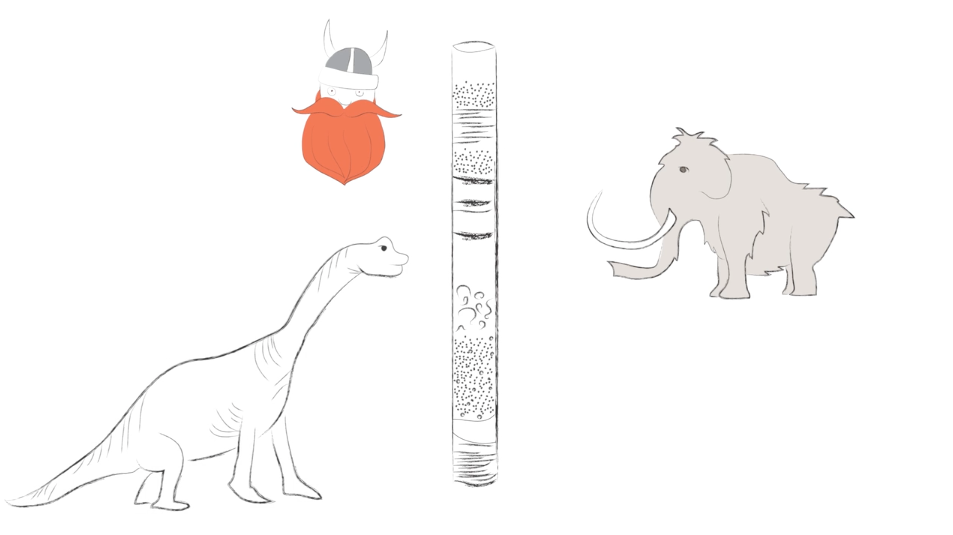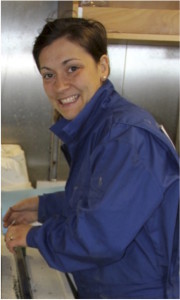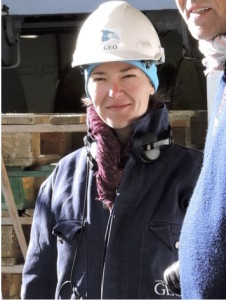
Story by: Evangeline Sessford, Amandine Tisserand og Sarah Berben
Finding, extracting and reading stories of the ocean´s past.
In the basement of Realfagsbygget at the University of Bergen, there are 80 m2 of tubes containing mud, sand and very tiny fossils. All of those tubes are very precious, because they contain important information of our past climate.
The fossils come from tiny animals that lived in the ocean water and when they died, settled to the sea floor of our earth’s oceans. Over time the mud and plankton skeletons accumulated layer by layer, year after year. These separate layers on the ocean floor tell a story in a very similar way to pages of a book, with the beginning of the story at the bottom and the end at the top of the sea floor. In particular, these layers of mud, known as marine sediment, tell us about changes in temperature

, salinity and sea ice from long before we began making observations or using satellites for research.
The ocean mud holds an incredible active archive and story about the natural history of the oceans. It is up to us to open the book and read the pages to understand our Earth’s oceanic history and even more, what it can teach us. This way of studying the ocean´s past is one tool to learn more about the earth’s changing climate system, its dynamics and its environmental impacts.
Finding the story

In the summer of 2015, we set out to the Greenland Sea on board of the G.O. Sars to recover continuous records containing tens of thousands of years of mud. The overall purpose of this research campaign is to unravel the mysteries of the so-called
Dansgaard-Oeschger cycles. These events occurred during the last glacial and are associated with rapid temperature increases of up to 15 °C over Greenland taking place within a human lifetime. At the last climate conference (COP21) in Paris, a general agreement was reached to keep the global warming within 1.5 °C within this century.
With this aim in mind we wonder what could potentially happen if a climate warming of 15 °C would make the scene again. If we gain a better understanding of these events and in particular of its triggers, it will be possible to improve our prediction of the future earth´s climate change. Therefore we aim to investigate tens of thousands of years of old mud and see how past changes in ocean and sea ice behavior affected climate.
Extracting the story
To recover long, continuous records of marine sediment, we lowered a long tube into the water column until it reached the ocean floor. There, the tube was pushed 20 meters downward into the sediment to capture the separate layers of mud inside the tube, in exactly the same way as they were lying within the ocean´s floor.
The long and thin cylinder of layered marine sediment, called a marine sediment core, shows us distinctive stripes of varied colors and widths. On board the ship, these cores were cut into sections and split in half lengthways. Additionally, we examined them using non-destructive analysis.
Reading the story
After a successful field season, one half of the core will be sampled and further examined by research scientists and students. These cores, and their many layers of mud, reveal a unique record of the changes throughout time at the core location. Their

stories are ready and waiting to be read.
Some of the information has already been extracted! Sarah is using ash from volcanoes that erupted in the past to link the timing between the sediment cores and understand the chronology of the oceanic changes. Evangeline has measured some salinity and circulation changes of the ocean water at the surface and at depth. And Amandine is running the Mg/ca samples to gain insight on the temperature of the water in the past!
Follow the Story
As the earth is experiencing global warming today, and many questions remain about the future, looking at the climate changes of the past helps us to understand the climate system.
For example, how high can CO2 go without causing devastating changes in global climate through sea level rise, ice sheet melt, and changing precipitation patterns? Hence, climate research is incredibly relevant to our society and the health of our Earth.
Come with us on a climate adventure through the sneak previews on film and follow us on twitter with #ice2ice.